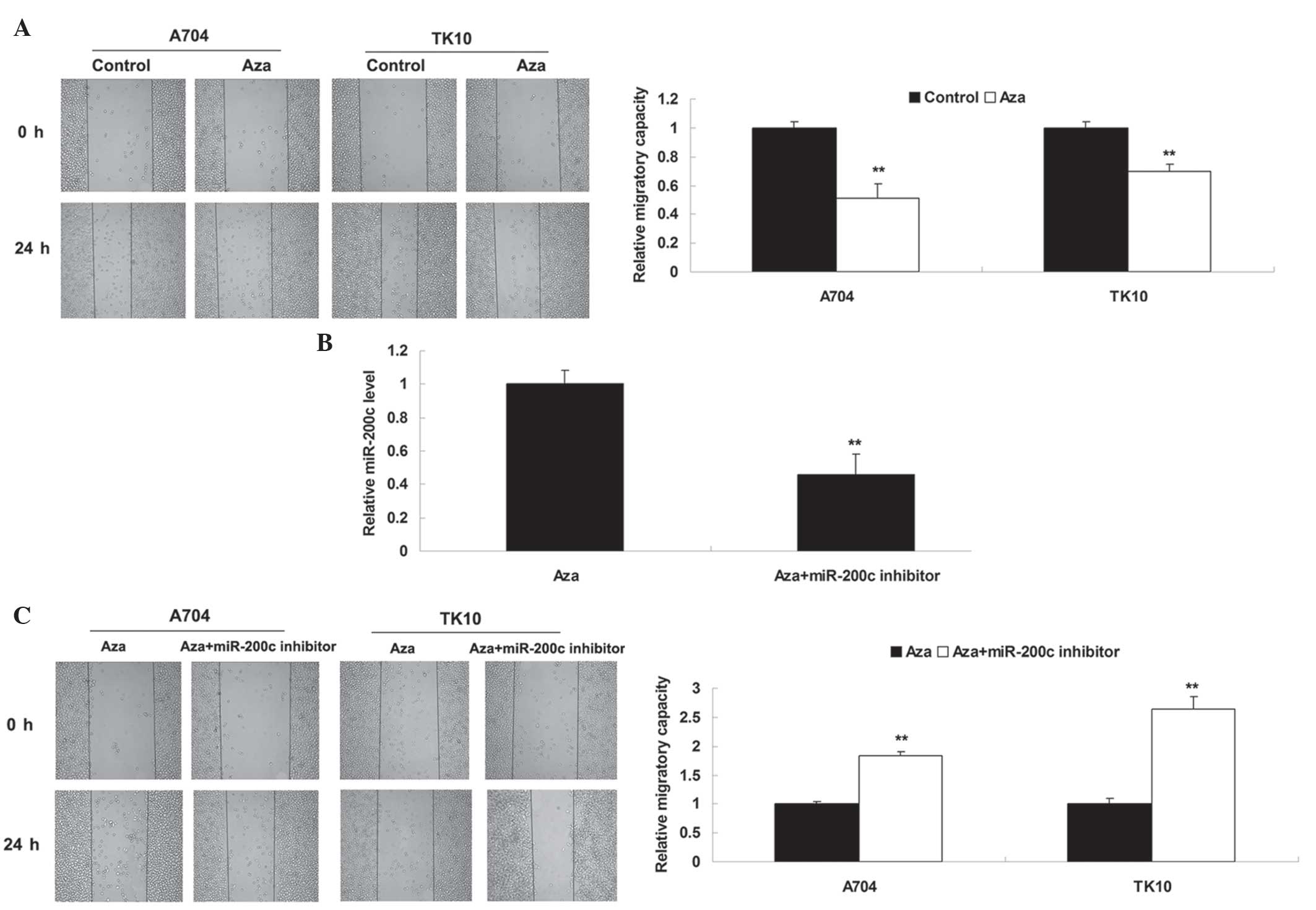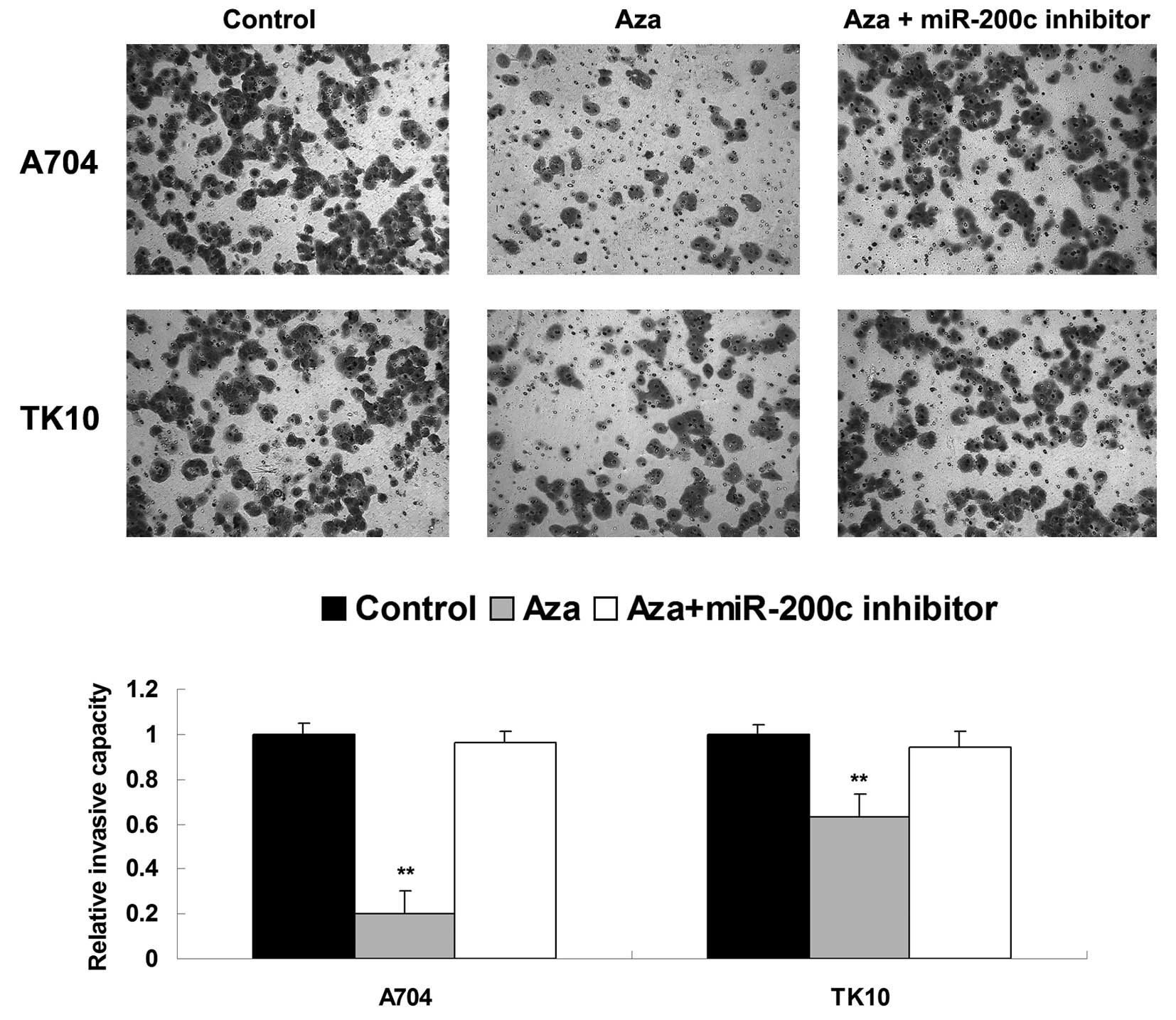|
1
|
Novick AC: Kidney cancer: Past, present,
and future. Urol Oncol. 25:188–195. 2007. View Article : Google Scholar : PubMed/NCBI
|
|
2
|
Chow WH, Dong LM and Devesa SS:
Epidemiology and risk factors for kidney cancer. Nat Rev Urol.
7:245–257. 2010. View Article : Google Scholar : PubMed/NCBI
|
|
3
|
Azeem K, Kollarova H, Horakova D,
Magnuskova S and Janout V: Genetic syndromes associated with renal
cell carcinoma: A review. Biomed Pap Med Fac Univ Palacky Olomouc
Czech Repub. 155:231–238. 2011. View Article : Google Scholar : PubMed/NCBI
|
|
4
|
Diamond E, Riches J, Faltas B, Tagawa ST
and Nanus DM: Immunologics and chemotherapeutics for renal cell
carcinoma. Semin Intervent Radiol. 31:91–97. 2014. View Article : Google Scholar : PubMed/NCBI
|
|
5
|
Rydzanicz M, Wrzesiński T, Bluyssen HA and
Wesoły J: Genomics and epigenomics of clear cell renal cell
carcinoma: Recent developments and potential applications. Cancer
Lett. 341:111–126. 2013. View Article : Google Scholar : PubMed/NCBI
|
|
6
|
Bartel DP: MicroRNAs: Genomics,
biogenesis, mechanism, and function. Cell. 116:281–297. 2004.
View Article : Google Scholar : PubMed/NCBI
|
|
7
|
Bartel DP: MicroRNAs: Target recognition
and regulatory functions. Cell. 136:215–233. 2009. View Article : Google Scholar : PubMed/NCBI
|
|
8
|
Lu J, Getz G, Miska EA, et al: MicroRNA
expression profiles classify human cancers. Nature. 435:834–838.
2005. View Article : Google Scholar : PubMed/NCBI
|
|
9
|
Watanabe K and Takai D: Disruption of the
expression and function of microRNAs in lung cancer as a result of
epigenetic changes. Front Genet. 4:2752013. View Article : Google Scholar : PubMed/NCBI
|
|
10
|
Gao YC and Wu J: MicroRNA-200c and
microRNA-141 as potential diagnostic and prognostic biomarkers for
ovarian cancer. Tumour Biol. 36:4843–4850. 2015. View Article : Google Scholar : PubMed/NCBI
|
|
11
|
Sun X, Luo S, He Y, et al: Screening of
the miRNAs related to breast cancer and identification of its
target genes. Eur J Gynaecol Oncol. 35:696–700. 2014.PubMed/NCBI
|
|
12
|
Zhou X, Wang Y, Shan B, et al: The
downregulation of miR-200c/141 promotes ZEB1/2 expression and
gastric cancer progression. Med Oncol. 32:4282015. View Article : Google Scholar : PubMed/NCBI
|
|
13
|
Liu L, Qiu M, Tan G, et al: miR-200c
inhibits invasion, migration and proliferation of bladder cancer
cells through down-regulation of BMI-1 and E2F3. J Transl Med.
12:3052014. View Article : Google Scholar : PubMed/NCBI
|
|
14
|
Shi R, Xiao H, Yang T, et al: Effects of
miR-200c on the migration and invasion abilities of human prostate
cancer Du145 cells and the corresponding mechanism. Front Med.
8:456–463. 2014. View Article : Google Scholar : PubMed/NCBI
|
|
15
|
Nakada C, Matsuura K, Tsukamoto Y, et al:
Genome-wide microRNA expression profiling in renal cell carcinoma:
Significant down-regulation of miR-141 and miR-200c. J Pathol.
216:418–427. 2008. View Article : Google Scholar : PubMed/NCBI
|
|
16
|
Liu H, Brannon AR, Reddy AR, et al:
Identifying mRNA targets of microRNA dysregulated in cancer: With
application to clear cell renal cell carcinoma. BMC Syst Biol.
4:512010. View Article : Google Scholar : PubMed/NCBI
|
|
17
|
Livak and Schmittgen: Analysis of relative
gene expression data using real-time quantitative PCR and the
2-ΔΔCt method. Methods. 25:402–408. 2001. View Article : Google Scholar : PubMed/NCBI
|
|
18
|
Furuta M, Kozaki KI, Tanaka S, et al:
miR-124 and miR-203 are epigenetically silenced tumor-suppressive
microRNAs in hepatocellular carcinoma. Carcinogenesis. 31:766–776.
2010. View Article : Google Scholar : PubMed/NCBI
|
|
19
|
Funasaka T, Raz A and Nangia-Makker P:
Galectin-3 in angiogenesis and metastasis. Glycobiology.
24:886–891. 2014. View Article : Google Scholar : PubMed/NCBI
|
|
20
|
Senanayake U, Das S, Vesely P, et al:
miR-192, miR-194, miR-215, miR-200c and miR-141 are downregulated
and their common target ACVR2B is strongly expressed in renal
childhood neoplasms. Carcinogenesis. 33:1014–1021. 2012. View Article : Google Scholar : PubMed/NCBI
|
|
21
|
Niu Y, Des Marais TL, Tong Z, Yao Y and
Costa M: Oxidative stress alters global histone modification and
DNA methylation. Free Radic Biol Med. 82:22–28. 2015. View Article : Google Scholar : PubMed/NCBI
|
|
22
|
Zhang D, Li Q, Rao L, Yi B and Xu Q:
Effect of 5-Aza-2′- deoxycytidine on odontogenic differentiation of
human dental pulp cells. J Endod. 41:640–645. 2015. View Article : Google Scholar : PubMed/NCBI
|
|
23
|
Lu YX, Yuan L, Xue XL, et al: Regulation
of colorectal carcinoma stemness, growth, and metastasis by an
miR-200c-Sox2-negative feedback loop mechanism. Clin Cancer Res.
20:2631–2642. 2014. View Article : Google Scholar : PubMed/NCBI
|
|
24
|
Tamagawa S, Beder LB, Hotomi M, et al:
Role of miR-200c/miR-141 in the regulation of
epithelial-mesenchymal transition and migration in head and neck
squamous cell carcinoma. Int J Mol Med. 33:879–886. 2014.PubMed/NCBI
|
|
25
|
Li J, Tan Q, Yan M, et al: miRNA-200c
inhibits invasion and metastasis of human non-small cell lung
cancer by directly targeting ubiquitin specific peptidase 25. Mol
Cancer. 13:1662014. View Article : Google Scholar : PubMed/NCBI
|
|
26
|
Hristov M, Erl W and Weber PC: Endothelial
progenitor cells: Mobilization, differentiation, and homing.
Arterioscler Thromb Vasc Biol. 23:1185–1189. 2003. View Article : Google Scholar : PubMed/NCBI
|
|
27
|
Kumar KJ, Vani MG, Chueh PJ, Mau JL and
Wang SY: Antrodin C inhibits epithelial-to-mesenchymal transition
and metastasis of breast cancer cells via suppression of Smad2/3
and β-catenin signaling pathways. PLoS One. 10:e01171112015.
View Article : Google Scholar : PubMed/NCBI
|
|
28
|
Wang M, Liu X, Jiang G, Chen H, Guo J and
Weng X: Relationship between LSD1 expression and E-cadherin
expression in prostate cancer. Int Urol Nephrol. 47:485–490. 2015.
View Article : Google Scholar : PubMed/NCBI
|














